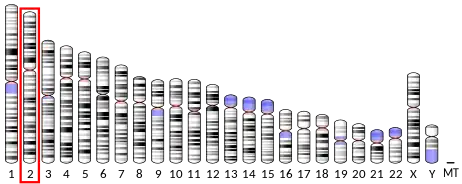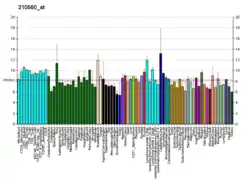Homeobox protein GBX-2 is a protein that in humans is encoded by the GBX2 gene.[5][6][7]
Summary
Gastrulation Brain Homeobox 2, or commonly known as GBX2, is a type of transcription factor that aids in the arranging of the midbrain and hindbrain during gastrulation. The hindbrain is broken up into seven or eight rhombomeres during gastrulation and GBX2 is responsible for rhombomeres one through three. GBX2 also takes part in the signaling and expression of other genes. It has been said that there is a threshold requirement for the amount of GBX2, so what occurs depends on the amount expressed. For example, specific amounts of GBX2 is needed for regulating the anterior and posterior patterning in the hindbrain. If the specific threshold is not met, then the patterning does not occur. This is the case with the other genes it helps to express like FGF8. With every gene comes some diseases associated with it. Colon Small Cell Carcinoma and Optiz-Gbbb Syndrome, which causes abnormalities throughout the midline of the body, are the diseases most closely associated with the GBX2 gene. [8]
Function
Gastrulation Brain Homeobox 2 (GBX2) is a homeobox gene involved in the normal development of rhombomeres 1-3 which is the mid/hindbrain region. This gene is a dosage dependent transcription factor involved in the regulation of proper expression of other genes. GBX2 expression occurs during gastrulation and continues to be expressed in the later stages of embryogenesis. During these different stages, GBX2 is responsible for several important processes. In the neural plate stage GBX2 is required in order for the anterior hindbrain precursors to survive and form correctly. Also at this stage in development GBX2 is required for the proper regulation of different gene expression needed for the early establishment of A/P patterning in the neural plate. In the early stages of brain morphogenesis GBX2 is required for both the normal development of the anterior hindbrain and the proper formation of the mid/hindbrain organizer. Because of the effects on the mid/hindbrain organizer, GBX2 is involved in the positioning of the expression domain for isthmic FGF8. Since this is a dosage dependent gene, the different amounts of gene present in certain location can cause different outcomes. FGF8 is affected by the different dosages in the location it is expressed. The absence of GBX2 causes FGF8 expression is shifted caudally and over expression of GBX2 causes FGF8 expression to be shifted rostrally. Not all of the rhombomeres GBX2 is expressed in require the same strictness of dose regulation. Of the three, rhombomere 2 has the most strict dose requirements.
Neural Crest Cell Development
The Gbx-2 gene is thought to be involved in neural crest cell patterning and differentiation during fetal growth as a transcription factor. As a zygote becomes a gastrula, the embryonic ectoderm differentiates into these neural crest cells, which give rise to many structures including muscle, neurons, and bone later in development. In order to test Gbx-2's role in neural crest cell development, the region of neural cell proliferation was injected with the morphogen Wnt8. In response, Snail2 was expressed, which led to transcription factor activation and subsequent protein formation. When Wnt8 was inhibited in the same region, no transcription factors were expressed and neural cell growth was inhibited or not seen. There have also been studies that showed that when the reverse occurred, with the absence or presence of Snail2 affecting Wnt8, similar effects to transcription factor activation occurred. Such research has shown that transcription factor activation is dependent on both genes. Wnt is thought to be a neural crest cell inducer, and Gbx-2 is one of the gene targets involved.[9] In cases where Gbx-2 mRNA is in excess, an expansion of neural crest cells is seen, whereas when there is a lack of mRNA, neural crest cells fail to proliferate. If neural crest cells are unable to proliferate, many of the body's important organs and processes will be inhibited and could likely lead to miscarriage of the fetus.
Animal studies
Knockout of the GBX2 gene causes the failure of many structures to form, such as the isthmic nuclei, the cerebellum, motor nerve V and many other derivatives of rhombomeres 1-3. GBX2 gene knockout embryos will continue to develop and will reach full term pregnancy. The babies are born but if there is a lack of GBX2 expression all will die soon after birth.[10][11]
Knockdown of the gbx2 gene leads to a truncated anterior hindbrain as well as abnormal clusters of cell bodies in r2 and r3 which are associated with problems in cranial nerve V. It has been shown that any structures derived from r1-r3 will be adversely affected by mutations or deficiencies in gbx2. These structures include the aortic arch and right Subclavian artery which, when improperly developed, can lead to cardiovascular defects in addition to craniofacial defects from improper development of cranial nerve V.[12]
References
- 1 2 3 GRCh38: Ensembl release 89: ENSG00000168505 - Ensembl, May 2017
- 1 2 3 GRCm38: Ensembl release 89: ENSMUSG00000034486 - Ensembl, May 2017
- ↑ "Human PubMed Reference:". National Center for Biotechnology Information, U.S. National Library of Medicine.
- ↑ "Mouse PubMed Reference:". National Center for Biotechnology Information, U.S. National Library of Medicine.
- ↑ Kowenz-Leutz E, Herr P, Niss K, Leutz A (Oct 1997). "The homeobox gene GBX2, a target of the myb oncogene, mediates autocrine growth and monocyte differentiation". Cell. 91 (2): 185–95. doi:10.1016/S0092-8674(00)80401-8. PMID 9346236. S2CID 15954797.
- ↑ Lin X, Swaroop A, Vaccarino FM, Murtha MT, Haas M, Ji X, Ruddle FH, Leckman JF (Feb 1996). "Characterization and sequence analysis of the human homeobox-containing gene GBX2". Genomics. 31 (3): 335–42. doi:10.1006/geno.1996.0056. PMID 8838315.
- ↑ "Entrez Gene: GBX2 gastrulation brain homeobox 2".
- ↑ Waters, S. T. “A Threshold Requirement for Gbx2 Levels in Hindbrain Development.” Development, vol. 133, no. 10, 2006, pp. 1991–2000., doi:10.1242/dev.02364.
- ↑ Li, Bo, et al. (1 Oct 2009). "The Posteriorizing Gene Gbx2 Is a Direct Target of Wnt Signalling and the Earliest Factor in Neural Crest Induction". Development. The Company of Biologists Ltd. 136 (19): 3267–3278. doi:10.1242/dev.036954. PMC 2808295. PMID 19736322.
- ↑ Wassarman KM, Lewandoski M, Campbell K, Joyner AL, Rubenstein JL, Martinez S, Martin GR (Aug 1997). "Specification of the anterior hindbrain and establishment of a normal mid/hindbrain organizer is dependent on Gbx2 gene function". Development. 124 (15): 2923–34. doi:10.1242/dev.124.15.2923. hdl:10261/338165. PMID 9247335.
- ↑ Waters ST, Lewandoski M (May 2006). "A threshold requirement for Gbx2 levels in hindbrain development". Development. 133 (10): 1991–2000. doi:10.1242/dev.02364. PMID 16651541.
- ↑ Nakayama Y, Kikuta H, Kanai M, Yoshikawa K, Kawamura A, Kobayashi K, Wang Z, Khan A, Kawakami K, Yamasu K (2013). "Gbx2 functions as a transcriptional repressor to regulate the specification and morphogenesis of the mid-hindbrain junction in a dosage- and stage-dependent manner". Mechanisms of Development. 130 (11–12): 532–52. doi:10.1016/j.mod.2013.07.004. PMID 23933069.
Further reading
- Burroughs-Garcia J, Sittaramane V, Chandrasekhar A, Waters ST (Apr 2011). "Evolutionarily conserved function of Gbx2 in anterior hindbrain development". Developmental Dynamics. 240 (4): 828–38. doi:10.1002/dvdy.22589. PMID 21360792. S2CID 19225250.
- Heimbucher T, Murko C, Bajoghli B, Aghaallaei N, Huber A, Stebegg R, Eberhard D, Fink M, Simeone A, Czerny T (Jan 2007). "Gbx2 and Otx2 interact with the WD40 domain of Groucho/Tle corepressors". Molecular and Cellular Biology. 27 (1): 340–51. doi:10.1128/MCB.00811-06. PMC 1800652. PMID 17060451.
- Glinsky GV, Berezovska O, Glinskii AB (Jun 2005). "Microarray analysis identifies a death-from-cancer signature predicting therapy failure in patients with multiple types of cancer". The Journal of Clinical Investigation. 115 (6): 1503–21. doi:10.1172/JCI23412. PMC 1136989. PMID 15931389.
- Gao AC, Lou W, Isaacs JT (Feb 2000). "Enhanced GBX2 expression stimulates growth of human prostate cancer cells via transcriptional up-regulation of the interleukin 6 gene". Clinical Cancer Research. 6 (2): 493–7. PMID 10690529.
- Gao AC, Lou W, Isaacs JT (Apr 1998). "Down-regulation of homeobox gene GBX2 expression inhibits human prostate cancer clonogenic ability and tumorigenicity". Cancer Research. 58 (7): 1391–4. PMID 9537237.
- Matsui T, Hirai M, Hirano M, Kurosawa Y (Dec 1993). "The HOX complex neighbored by the EVX gene, as well as two other homeobox-containing genes, the GBX-class and the EN-class, are located on the same chromosomes 2 and 7 in humans". FEBS Letters. 336 (1): 107–10. doi:10.1016/0014-5793(93)81620-F. PMID 7903253. S2CID 34546387.
- Li, Bo, et al. (1 Oct 2009). "The Posteriorizing Gene Gbx2 Is a Direct Target of Wnt Signalling and the Earliest Factor in Neural Crest Induction". Development. The Company of Biologists Ltd. 136 (19): 3267–3278. doi:10.1242/dev.036954. PMC 2808295. PMID 19736322.




